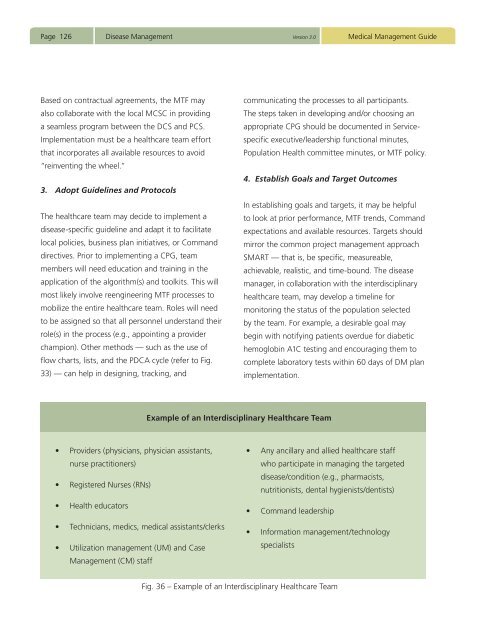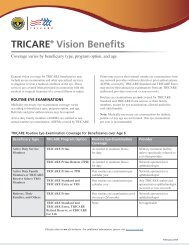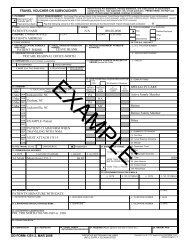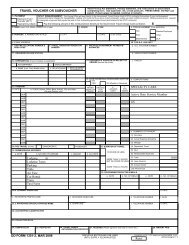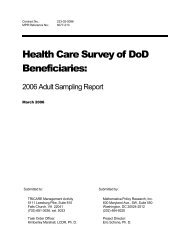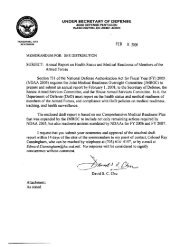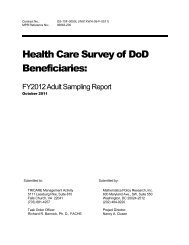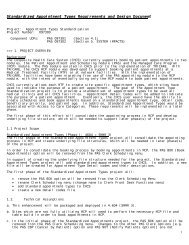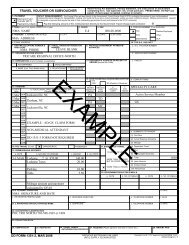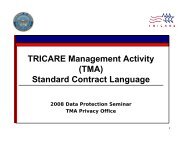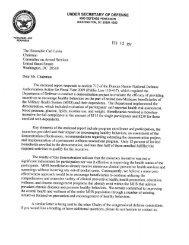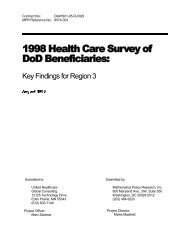Medical Management Guide, 2009, Version 3.0 - Tricare
Medical Management Guide, 2009, Version 3.0 - Tricare
Medical Management Guide, 2009, Version 3.0 - Tricare
- No tags were found...
Create successful ePaper yourself
Turn your PDF publications into a flip-book with our unique Google optimized e-Paper software.
Page 126Disease <strong>Management</strong> <strong>Version</strong> <strong>3.0</strong><strong>Medical</strong> <strong>Management</strong> <strong>Guide</strong>Based on contractual agreements, the MTF mayalso collaborate with the local MCSC in providinga seamless program between the DCS and PCS.Implementation must be a healthcare team effortthat incorporates all available resources to avoid“reinventing the wheel.”3. Adopt <strong>Guide</strong>lines and ProtocolsThe healthcare team may decide to implement adisease-specific guideline and adapt it to facilitatelocal policies, business plan initiatives, or Commanddirectives. Prior to implementing a CPG, teammembers will need education and training in theapplication of the algorithm(s) and toolkits. This willmost likely involve reengineering MTF processes tomobilize the entire healthcare team. Roles will needto be assigned so that all personnel understand theirrole(s) in the process (e.g., appointing a providerchampion). Other methods — such as the use offlow charts, lists, and the PDCA cycle (refer to Fig.33) — can help in designing, tracking, andcommunicating the processes to all participants.The steps taken in developing and/or choosing anappropriate CPG should be documented in Servicespecificexecutive/leadership functional minutes,Population Health committee minutes, or MTF policy.4. Establish Goals and Target OutcomesIn establishing goals and targets, it may be helpfulto look at prior performance, MTF trends, Commandexpectations and available resources. Targets shouldmirror the common project management approachSMART — that is, be specific, measureable,achievable, realistic, and time-bound. The diseasemanager, in collaboration with the interdisciplinaryhealthcare team, may develop a timeline formonitoring the status of the population selectedby the team. For example, a desirable goal maybegin with notifying patients overdue for diabetichemoglobin A1C testing and encouraging them tocomplete laboratory tests within 60 days of DM planimplementation.Example of an Interdisciplinary Healthcare Team• Providers (physicians, physician assistants,nurse practitioners)• Registered Nurses (RNs)• Health educators• Technicians, medics, medical assistants/clerks• Utilization management (UM) and Case<strong>Management</strong> (CM) staff• Any ancillary and allied healthcare staffwho participate in managing the targeteddisease/condition (e.g., pharmacists,nutritionists, dental hygienists/dentists)• Command leadership• Information management/technologyspecialistsFig. 36 – Example of an Interdisciplinary Healthcare Team


